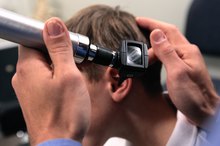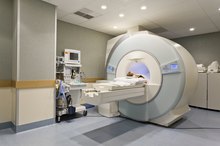Parts of the Brain That Influence Creativity
Creativity can be described loosely as the application of novel solutions and possibilities to some aspect of human endeavor. Creativity is easy to identify but notoriously difficult to measure. However, armed with the latest generation of brain imagery technologies, neuroscientists have made real gains in isolating where creativity lives in the brain. Many parts of the brain influence creativity, and, surprisingly, just as important are the parts of the brain that are not active during creative reverie.
Left Brain and Right Brain
In years past, researchers maintained that creativity was higher in individuals who are right-brain thinkers. Known as brain lateralization, this theory maintains that the right brain lobe is more highly activated in left-handed individuals. Everything from divergent thinking, artistic streaks and quicker information processing was attributed to so-called right-brain thinkers.
Modern-day researchers such as Rita Carter, author of “Mapping the Mind,” believe that more important to the creative drive is level of communication between the two lobes of the brain. The corpus callosum, the part of the brain that connects the two lobes, is thicker in diameter in people who score highly on creativity tests. The thicker the corpus callosum, the more efficiently the brain synchronizes its activities. This idea, first published in 1988 by Joseph and Glenda Bogen in the journal for Psychiatric Clinics of North America, has gained increasing support by recent brain imaging technology. In other words, creativity is enhanced by an increased use of the whole brain.
- In years past, researchers maintained that creativity was higher in individuals who are right-brain thinkers.
The Role of Norepinephrine
What Parts of the Brain Produce Dreams?
Learn More
Creativity is not determined by brain lateralization alone. Dr. Kenneth M. Heilman, professor of neurology at the University of Florida, notes that during creative thought, the neurotransmitter norepinephrine is greatly reduced. Norepinephrine is associated with long-term memory retrieval, so its reduction during creative thinking helps the brain to forget what it already knows. In this way, novel connections and new ideas are more likely to be discovered.
- Creativity is not determined by brain lateralization alone.
- Norepinephrine is associated with long-term memory retrieval, so its reduction during creative thinking helps the brain to forget what it already knows.
Suppression of Critical Thought
Another surprising discovery about the science of creativity was made by researchers Charles Limb and Allen Braud, who performed brain imagery scans on jazz musicians. While the musicians made spontaneous compositions, several higher brain functions in the prefrontal cortex were suppressed. This part of the brain is associated with conscious control as well as self-monitoring. Perhaps the folk psychology idea that the “critic” must be silenced during creative thought is reflected in these findings. Limb and Braud also report that the limbic centers of the brain are unregulated during creative improvision, providing neurological support for the role of heightened emotion during creative pursuits.
Taken together, these neurological findings suggest that creativity is reflected in the brain as increased lateralization, as a reduction in critical thinking and long-term memory and as heightened emotionality.
- Another surprising discovery about the science of creativity was made by researchers Charles Limb and Allen Braud, who performed brain imagery scans on jazz musicians.
- Taken together, these neurological findings suggest that creativity is reflected in the brain as increased lateralization, as a reduction in critical thinking and long-term memory and as heightened emotionality.
Related Articles
References
- SingSurf: Left brain, right brain, whole brain?
- Neuropsychology Reviews: Exploring the brain’s role in creativity
- National Center for Biotechnology Information: Neural Substrates of Spontaneous Musical Performance
- The science of creativity. American Psychological Association.
- Csikszentmihalyi M. Creativity: Flow and the Psychology of Discovery and Invention. New York: HarperCollins; 2013.
- 10. Kaufman J, Beghetto R. Beyond Big and Little: The Four C Model of Creativity. Review of General Psychology. 2009;13(1):1-12. doi:10.1037/a0013688
- Elliot J. Conversations With Maya Angelou. Jackson, Miss.: University Press of Mississippi; 1998.
Writer Bio
Ryan Hurd is a writer and consciousness studies researcher living in California. His dream expertise has been featured in the Huffington Post and Psychology Today. Hurd has an M.A. in consciousness studies, and is the author of "Enhance your dream life."








